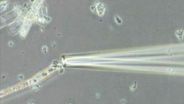(Press-News.org) Two newer drugs used to treat Type 2 diabetes could be linked to a significantly increased risk of developing pancreatitis and pancreatic cancer, and one could also be linked to an increased risk of thyroid cancer, according to a new UCLA study.
Researchers from the Larry L. Hillblom Islet Research Center at UCLA examined the U.S. Food and Drug Administration's database for adverse events reported between 2004 and 2009 among patients using the drugs sitagliptin and exenatide. They found a six-fold increase in the odds ratio for reported cases of pancreatitis with these drugs, compared with four other diabetes therapies they used as controls. They also found that patients who took the two drugs were more likely to have developed pancreatic cancer than those who were treated with the other therapies.
The study is published in the journal Gastroenterology.
"We undertook these studies because several studies in animal models by several investigators had suggested that this form of therapy may have unintended actions to promote growth of the ducts (tubes) in the pancreatic gland that convey digestive juices from the pancreas to the gut," said Dr. Peter Butler, director of the Hillblom Center and a study co-author. "This is a concern if it happens in humans since it might be expected to increase the risk for pancreatitis and pancreatic cancer. While the FDA data base has limitations, it does have advantages in being very large, openly accessible and independent from companies that market the drugs.
"Taken together the animals studies and the FDA data base analysis suggest that further work needs to be undertaken to at least rule out that this now widely available new drug class for diabetes does not increase the risk of pancreatic cancer," Butler, who is also a member of UCLA's Jonsson Comprehensive Cancer Center, added.
Sitagliptin and exenatide are drugs that enhance the actions of a gut hormone known as glucagon-like peptide 1 (GLP-1), which has been shown to be effective in lowering blood sugar in individuals with Type 2 diabetes. Sitagliptin, marketed as Januvia by Merck & Co. Inc., works by inhibiting dipeptidyl peptidase-4 (DDP-4), an enzyme that degrades GLP-1. Exenatide, manufactured by Amylin Pharmaceuticals and sold as Byetta, mimics the action of GLP-1 and resists DDP-4 degradation.
Previous research by UCLA Hillblom Center researchers suggested there might be a link between drugs that enhance the actions of GLP-1 and pancreatitis, possibly resulting from an increase in the rate of formation of cells that line the pancreatic ducts. That research, based on studies in rats, was published in 2009 in the journal Diabetes.
In addition to the six-fold increase in reported cases of pancreatitis, the researchers also found a 2.9-fold greater rate of pancreatic cancer in patients using exenatide and a 2.7-fold higher rate of pancreatic cancer in patients on sitagliptin, compared with the other therapies. Additionally, they found a statistically significant increase in the risk of thyroid cancer among the exenatide group, but not among the sitagliptin group.
The FDA data did not indicate links between the two diabetes drugs and any other form of cancer.
The researchers caution that the FDA's adverse events database "is not the ideal mechanism to compare adverse event rates between drugs," given its known limitations, such as incomplete data and reporting biases. They stress that more study is needed.
"Randomized, controlled clinical trials remain the gold standard for such assessment," the researchers wrote.
###
The Larry L. Hillblom Foundation funded this study. Study co-authors are Michael
Elashoff, Aleksey V. Matveyenko, Belinda Gier, and Robert Elashoff, all of UCLA.
The Larry L. Hillblom Islet Research Center at UCLA, opened in November 2004, is the first center dedicated to the study of the islets of Langerhans, which include the insulin-producing cells in the pancreas. An understanding of the causes of islet cell destruction is key to finding a cure for diabetes. The center's faculty members, recruited from around the world, provide leadership in the worldwide fight against the disease. The center is made possible through a grant from the Larry Hillblom Foundation, established to support medical research in the state of California.
UCLA's Jonsson Comprehensive Cancer Center has more than 240 researchers and clinicians engaged in disease research, prevention, detection, control, treatment and education. One of the nation's largest comprehensive cancer centers, the Jonsson Center is dedicated to promoting research and translating basic science into leading-edge clinical studies. In July 2011, the center was named among the top 10 cancer centers nationwide by U.S. News & World Report, a ranking it has held for 10 of the last 12 years.
Study suggests possible link between two Type 2 diabetes drugs and pancreatic cancer
2011-09-19
ELSE PRESS RELEASES FROM THIS DATE:
People born after World War II are more likely to binge drink and develop alcohol disorders
2011-09-19
September 15, 2011 --. In a review of 31 peer-reviewed and published studies, researchers at Columbia University's Mailman School of Public Health looked generational and gender differences in alcohol consumption, alcohol disorders, and mortality. Findings indicate that people born after World War II are more likely to binge drink and develop alcohol use disorders. Researchers also found that the gender gap in alcoholism and problem drinking is narrowing in many countries.
Findings will be published in the December 2011 issue of Alcoholism: Clinical & Experimental Research ...
Autism, intellectual disabilities related to parental age, education and ethnicity, not income
2011-09-19
SALT LAKE CITY – New research from the University of Utah in collaboration with the Utah Department of Health (UDOH) shows that the presence or absence of intellectual disability (ID) and autism spectrum disorders (ASD) varies with risk factors such as gender, parental age, maternal ethnicity, and maternal level of education. The study, published Sept. 15, 2011, in Autism Research, also shows that household income level has no association with either ID or ASD, in contrast to what other studies have suggested.
ASDs are a group of childhood neurodevelopmental disorders ...
Good news for rural stroke patients: Virtual stroke care appears cost-effective
2011-09-19
ST. PAUL, Minn. – In a first of its kind study, researchers have found that using two way audio-video telemedicine to deliver stroke care, also known as telestroke, appears to be cost-effective for rural hospitals that don't have an around-the-clock neurologist, or stroke expert, on staff. The research is published in the September 14, 2011, online issue of Neurology®, the medical journal of the American Academy of Neurology.
"In an era of spiraling health care costs, our findings give critical information to medical policy makers," said Jennifer J. Majersik, MD, MS, ...
Low-fat yogurt intake when pregnant may lead to child asthma and hay fever
2011-09-19
Amsterdam, The Netherlands: Eating low-fat yoghurt whilst pregnant can increase the risk of your child developing asthma and allergic rhinitis (hay fever), according to recent findings.
The study will be presented at the European Respiratory Society's (ERS) Annual Congress in Amsterdam on 25 September 2011. All the abstracts for the ERS Congress will be publicly available online from today (17 September 2011).
The study aimed to assess whether fatty acids found in dairy products could protect against the development of allergic diseases in children.
The researchers ...
Crystal structure shows how motor protein works
2011-09-19
The crystal structure of the dynamin protein — one of the molecular machines that makes cells work — has been revealed, bringing insights into a class of molecules with a wide influence on health and disease.
"It's a really cool structure," said Jodi Nunnari, professor and chair of molecular and cellular biology at UC Davis and senior author of the paper, to be published Sept. 18 in the journal Nature. "This is a really important class of molecules for regulating membrane dynamics."
The detailed structure reveals exactly how the dynamin protein can form large assemblies ...
Osteoporosis Phase III data at 2011 ASBMR Show oral calcitonin tablet is safe and effective
2011-09-19
SAN DIEGO, CA and PHILADELPHIA, PA – September 18, 2011 —Tarsa Therapeutics today presented positive safety and efficacy data from its Phase III ORACAL trial of OSTORA™, the company's oral recombinant salmon calcitonin tablet in development for the treatment of postmenopausal osteoporosis. These data were presented at the American Society for Bone and Mineral Research 2011 Annual Meeting by ORACAL investigator Neil Binkley, MD, who is an Associate Professor of Endocrinology and Geriatrics at the University of Wisconsin School of Medicine and Public Health in Madison, ...
Why carbon nanotubes spell trouble for cells
2011-09-19
VIDEO:
Receptors on the cell's surface crowd around the nanotube, effectively standing it upright. The cell mistakes the tube for a sphere and begins to engulf it.
Click here for more information.
PROVIDENCE, R.I. [Brown University] — It's been long known that asbestos spells trouble for human cells. Scientists have seen cells stabbed with spiky, long asbestos fibers, and the image is gory: Part of the fiber is protruding from the cell, like a quivering arrow that's found ...
Researchers sequence dark matter of life
2011-09-19
Researchers have developed a new method to sequence and analyze the dark matter of life—the genomes of thousands of bacteria species previously beyond scientists' reach, from microorganisms that produce antibiotics and biofuels to microbes living in the human body.
Scientists from UC San Diego, the J. Craig Venter Institute and Illumina Inc., published their findings in the Sept. 18 online issue of the journal Nature Biotechnology. The breakthrough will enable researchers to assemble virtually complete genomes from DNA extracted from a single bacterial cell. By contrast, ...
Deep oceans can mask global warming for decade-long periods
2011-09-19
BOULDER -- The planet's deep oceans at times may absorb enough heat to flatten the rate of global warming for periods of as long as a decade even in the midst of longer-term warming, according to a new analysis led by the National Center for Atmospheric Research (NCAR).
The study, based on computer simulations of global climate, points to ocean layers deeper than 1,000 feet (300 meters) as the main location of the "missing heat" during periods such as the past decade when global air temperatures showed little trend. The findings also suggest that several more intervals ...
Purdue technology used in first fluorescence-guided ovarian cancer surgery
2011-09-19
WEST LAFAYETTE, Ind. - The first fluorescence-guided surgery on an ovarian cancer patient was performed using a cancer cell "homing device" and imaging agent created by a Purdue University researcher.
The surgery was one of 10 performed as part of the first phase of a clinical trial to evaluate a new technology to aid surgeons in the removal of malignant tissue from ovarian cancer patients. The method illuminates cancer cells to help surgeons identify and remove smaller tumors that could otherwise be missed.
Philip Low, the Ralph C. Corely Distinguished Professor of ...


